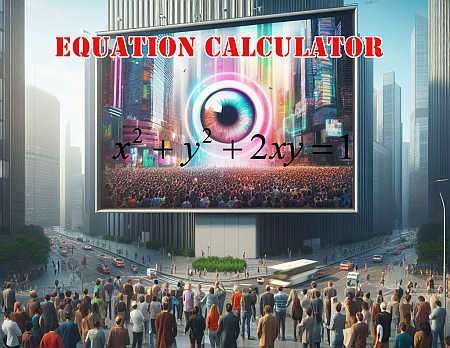Numerical Expression
Instructions: Use this calculator to compute and simplify a provided numerical expression, showing all the steps of the calculation. Please type in the numerical expression you want to simplify in the box below.
Numerical Expression Calculator
Use this tool to calculate and simplify a numerical expression you provide. This expression can involve numbers, fractions or any numerical expression that is well defined (think 'sqrt(2)', 'sin(pi/2)' , etc.
Once valid expression has been type, in order to get the solution and the steps taken, just click on "Calculate".
What is a Numerical Expression?
A numerical expression is a mathematical phrase that combines numbers and operations without an equal sign or inequality. It is a way to express a calculation or a series of calculations that you can perform to get a result. For example, \(5 + 3\) or \(10 \times 2\) are numerical expressions.

Examples of Numerical Expressions
Here are some examples of very simple numerical expressions:
- \(8 - 4\)
- \(15 \div 3\)
- \(2 \times (7 + 3)\)
Each of these expressions involves basic arithmetic operations like addition, subtraction, multiplication, and division. They also involves PEMDAS rules, which govern operation priority, which is which operation are done first.
How to Write Numerical Expressions
There is not one rule written in stone for writing expression. Numerical expressions can take infinite shapes and forms. Though, writing a numerical expression involves almost always:
- Identifying the numbers you want to use.
- Choosing the operations to connect these numbers.
- Using parentheses if necessary to clarify the order of operations and to adhere to PEMDAS.
For instance, if you want to express "add 5 to the product of 3 and 4", you would write it as \(3 \times 4 + 5\).
Numerical Expressions for 4th Grade
The difficulty of numerical expressions vary according to the grade of students exposed to them. For example, at the 4th-grade level, numerical expressions often involve operations like:
- Simple addition and subtraction like \(7 + 3\) or \(12 - 8\).
- Basic multiplication and division, such as \(6 \times 2\) or \(16 \div 4\).
At 4th grade trig expressions or radical expressions are not yet covered usually. Starting with simple additions, subtractions, multiplications and divisions help students understand the basics of arithmetic operations.
Numerical Expressions for 5th Grade
In 5th grade, students will start to face more challenges, starting with things like:
- Expressions with parentheses, like \(2 \times (5 + 3)\).
- More complex operations, including order of operations, e.g., \(10 - 2 \times 3\).
These expressions introduce the concept of grouping and the importance of following the correct order of operations.

Numerical Expressions for 6th Grade
By 6th grade, things start taking a more difficult shape, with numerical expressions that include:
- Exponents, such as \(2^3\).
- More complex operations with multiple steps, like \(5 + (3 \times 2) - 1\).
These expressions challenge students to apply their understanding of arithmetic in more complex and challenging scenarios.
How to Solve Numerical Expressions?
Strictly speaking, unless there is an equality sign or we are solving an equation, we should not talk about "solving a numerical expressions", but rather about simplifying a numerical expression. Still, we will usually accept that colloquialism. So, to solve a numerical expression:
- First, evaluate expressions inside parentheses (the "P" in PEMDAS).
- Next, perform any exponents, multiplication or division from left to right ("E", "M" and "D" in PEMDAS).
- Then, do any addition or subtraction from left to right ("A" and "S" in PEMDAS).
For example, to solve \(5 + (3 \times 2) - 1\) we would need to:
- Calculate inside the parentheses: \(3 \times 2 = 6\).
- Add 5 to the result: \(5 + 6 = 11\).
- Subtract 1: \(11 - 1 = 10\).
What Are the Main Components of a Numerical Expression?
The main components of a numerical expression include:
- Numbers: The digits or numerals involved in the calculation.
- Operations: Addition (+), subtraction (-), multiplication (×), division (÷), and sometimes exponents (^).
- Functions: We could potentially include functions like square root, trigonometric functions, etc.
- Parentheses: These are used to group operations and clarify the order of operations.
Numerical Expression Example
Here you have a typical simple example of a numeric expression: \(4 \times (6 + 2)\). This expression on;y involves multiplication and addition within parentheses.

Why Are Numerical Expressions Important in Math?
Numerical expressions are fundamental in so many aspects of mathematics because:
- They provide the building blocks in which all math is based upon.
- They serve as a springboard to boost your understanding and application of more complex arithmetic operations.
- They give you elements of logical thinking and problem-solving abilities.
By understanding numerical expressions sufficiently well, students gain a solid foundation for mathematical journey.
Other interesting Algebra Calculators
If you're working with numerical expressions, you might find it useful to deal with all types of algebraic manipulations. For instance, our Algebraic Expression Calculator can help simplify or solve algebraic expressions, providing a deeper understanding of how numbers and variables interact.
Furthermore, if you're dealing with polynomials, our Polynomial Operations Calculator can assist in performing operations like addition, subtraction, multiplication, or even division of polynomials, which can be crucial when expanding or simplifying expressions.
Another tool that complements numerical work is the Scientific Notation Calculator. This is particularly handy when dealing with very large or very small numbers, making it easier to manage and understand the scale of your calculations. Whether you're in a scientific field or just need to handle long decimal numbers, this tool can streamline your work significantly.






